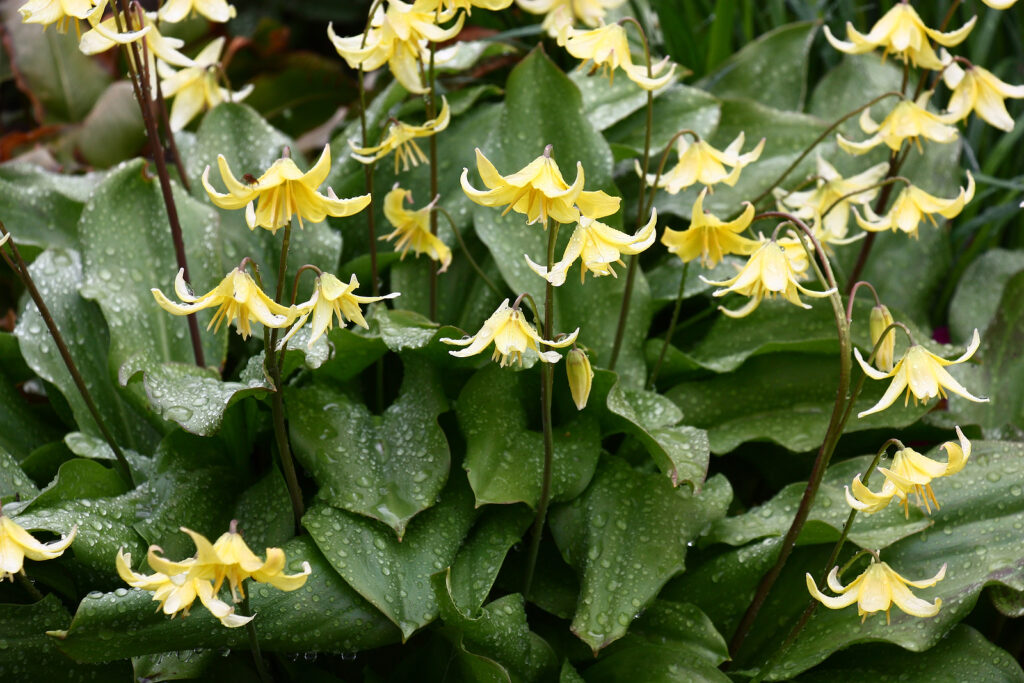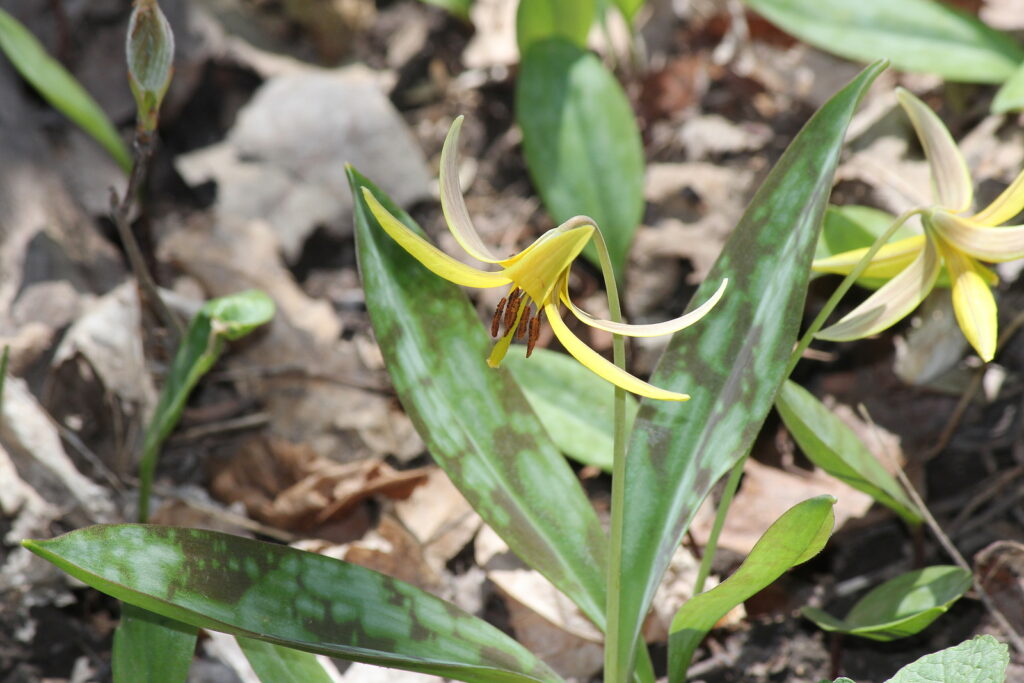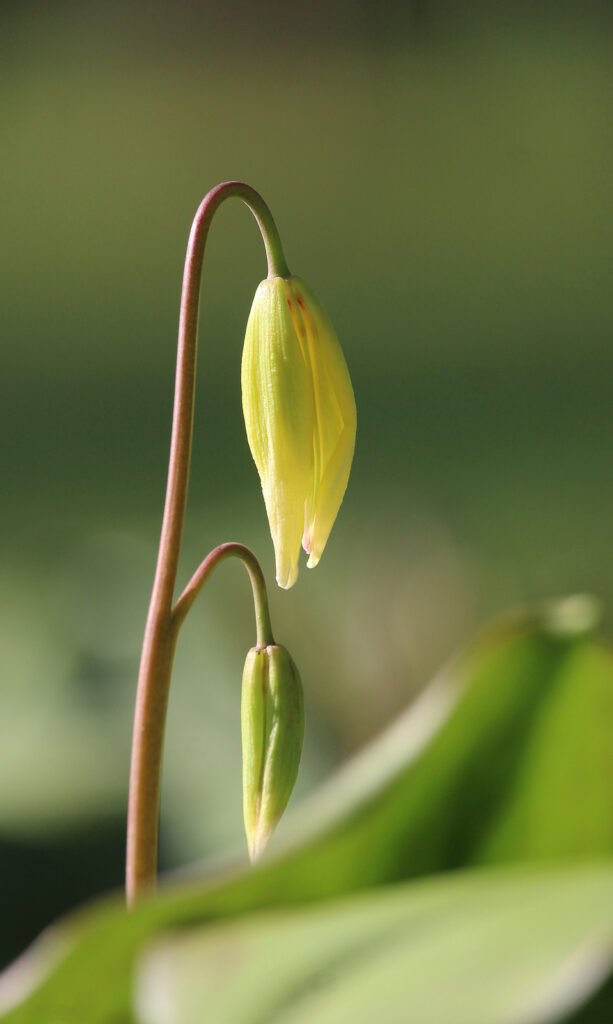Erythronium has several common names: trout lily, dogtooth violet, adder’s tongue, and fawn lily. Erythronium is grown for its nodding pink, white, yellow, or cream lilylike flowers that bloom from late spring to early summer.
Flowers are borne on leafless stalks. Each bloom has six petal-like tepals. In some species the tepals are strongly curved backwards.
In addition to the handsome, drooping lily-like flowers, Erythronium has interesting broad to oval-shaped leaves that are often handsomely mottled with brown or cream. Each plant produce two or three leaves that accentuate and compliment the color of the blossoms.
Erythronium grows in clumps. It can be planted under deciduous trees and shrubs, or in a rock garden or naturalized in thin grass.
There are bout 22 species in the Erythronium genus.

Get to know Erythronium
- Plant type: Bulb
- Growing zones and range: Zones 3 to 9.
- Hardiness: Hardy to Zone 3
- Height and width: 3 to 16 inches (7.6-40cm) tall and 4 to 6 inches (10-15cm) wide depending on the variety.
- Foliage: Broadly elliptic to ovate, usually basal leaves; many have marbled foliage, which accounts for the name “trout lily.”
- Flowers: Upright stems produce 1 to 10 pendent, lily-shaped blooms that are 1 to 2 inches across in shades of yellow, pink, white, and violet.
- Bloom time: Early spring
- Uses: Brighten up wildflower and rock gardens.
- Garden companions: Spring beauty (Claytonia virginica), crocuses, grape hyacinths (Muscari).
- Common name: Trout lilies, dogtooth violets, adder’s tongues.
- Botanical name: Erythronium
- Family name: Liliaceae
- Origin: Meadows of Europe, Asia, and North America
Where to plant Erythronium
- Plant Erythronium in light shade.
- Plant Erythronium in deeply prepared, humus-rich, moist, well-drained soil

When to plant Erythronium
- Plant the bulbs in the fall. Do not let bulbs dry out before planting; store them moist, but not wet sand or peat.
Planting and spacing Erythronium
- Plant Erythronium 4 to 6 inches (10-15cm) deep. Set the toothlike roots upright, not lengthwise.
- Space bulbs 6 inches (15cm) apart.
How to water and feed Erythronium
- Erythronium grows best in just moist soil; avoid dry soil.
- Fertilize Erythronium with an all-purpose organic fertilizer in spring.

How to care for Erythronium
- Mulch plantings with chopped leaves or aged compost or shredded bark to keep the soil cool and moist.
Erythronium pests and diseases
- Erythronium can be attacked by slugs.
- Erythronium can suffer rust, smuts, and fungal spots.
Erythronium propagation
- Divide established Erythronium clumps after flowering.
- Propagate by seeds which are slow to germinate and reach blooming size.
- Erythronium self sows.

Erythronium varieties to grow
- E. americanum, yellow adder’s tongue, native to the eastern U.S., has yellow flowers and brown-marbled green leaves. 3 to 6 inches (8-15cm) tall.
- E. californicum, fawn lily, is a California native with creamy white flowers, one to three a stem; grows to 1 foot (.3m) tall.
- E. dens-canis, European dogtooth violet, has pink, lavender, or white blooms. 6 inches (15cm) tall.
- E. grandiflorum is a species that grows 6 to 12 inches tall and bears yellow 2-inch-wide flowers in spring.
- E. hendersonii, dogtooth violet, is a wildflower in the Pacific Northwest; grows to 14 inches tall and beats pale lilac flowers in racemes of up to 10 flowers.
- E. ‘Pagoda’, a hybrid, is golden yellow, with 4 to 5 blossoms per stem. To 15 inches (38cm) tall.
- E. revolutum, western trout lily grows to 12 inches tall bears lilac-pink flowers in racemes; cultivar ‘Pink Beauty’ has deep lilac-pink blooms.
- E. toulumnense grows to 14 inches tall and bears yellow flowers in racemes in spring.















